Comprehensive Business Risk Management Report: Tesco's Strategies
VerifiedAdded on 2020/12/10
|17
|4547
|239
Report
AI Summary
This report provides a comprehensive analysis of business risk management strategies employed by Tesco, a leading retail company. It begins with an introduction to risk management principles and outlines the organizational processes and requirements for undertaking risk management in accordance with current standards. The report then delves into a description of Tesco's business, including its critical success factors, goals, objectives, and identification of both internal and external stakeholders. It also includes a PEST and SWOT analysis to assess the business environment. The core of the report focuses on identifying and evaluating both internal and external risks, including financial, operational, and environmental factors. It outlines the process for identifying different types of risks and provides a risk assessment matrix to evaluate and prioritize risks for treatment. Furthermore, the report presents a detailed risk management action plan, explaining how the risk treatment plan will be implemented, the required documentation, and the monitoring and evaluation processes. The report concludes with a stakeholder report and references to support the analysis, providing a holistic view of Tesco's risk management approach.
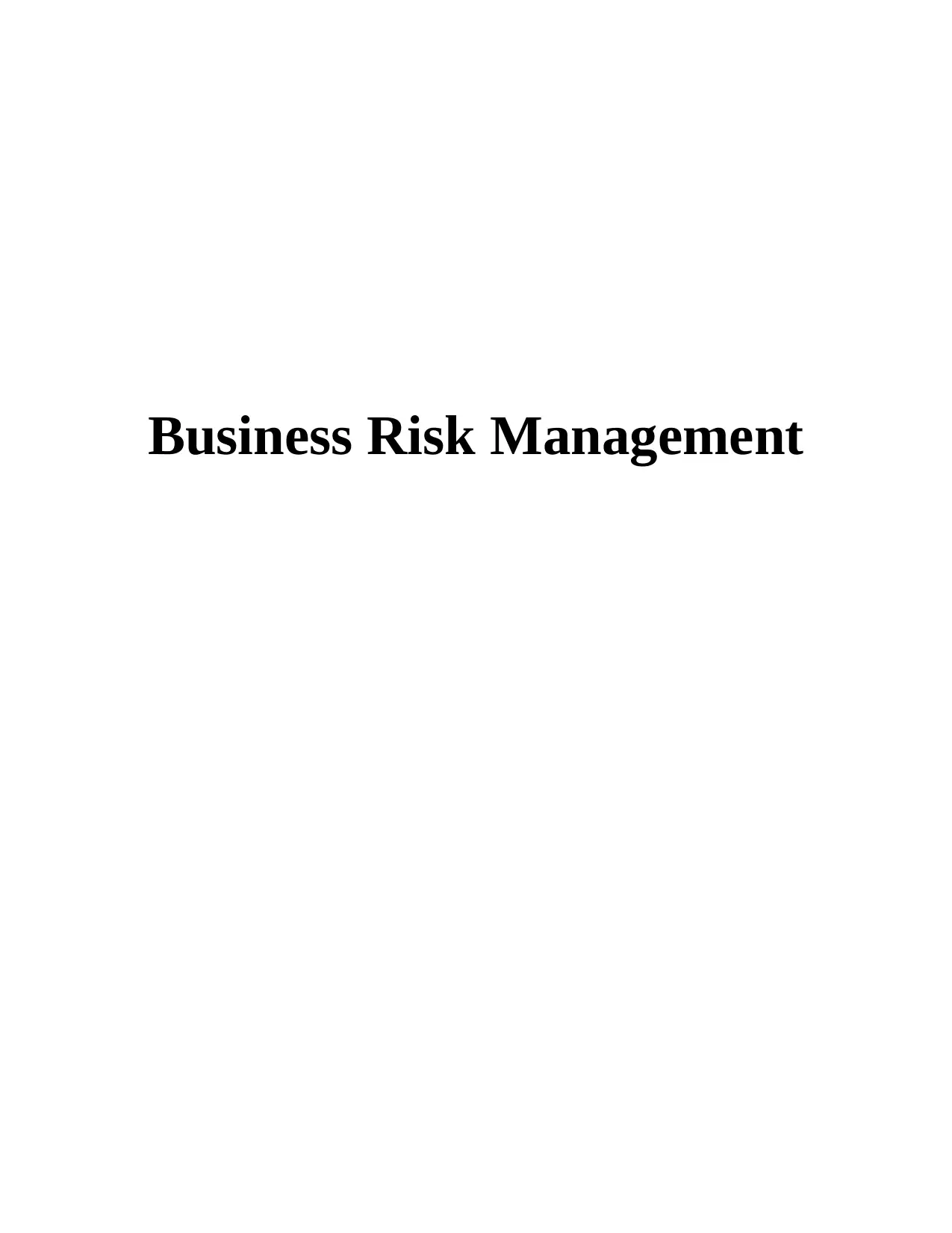
Business Risk Management
Paraphrase This Document
Need a fresh take? Get an instant paraphrase of this document with our AI Paraphraser
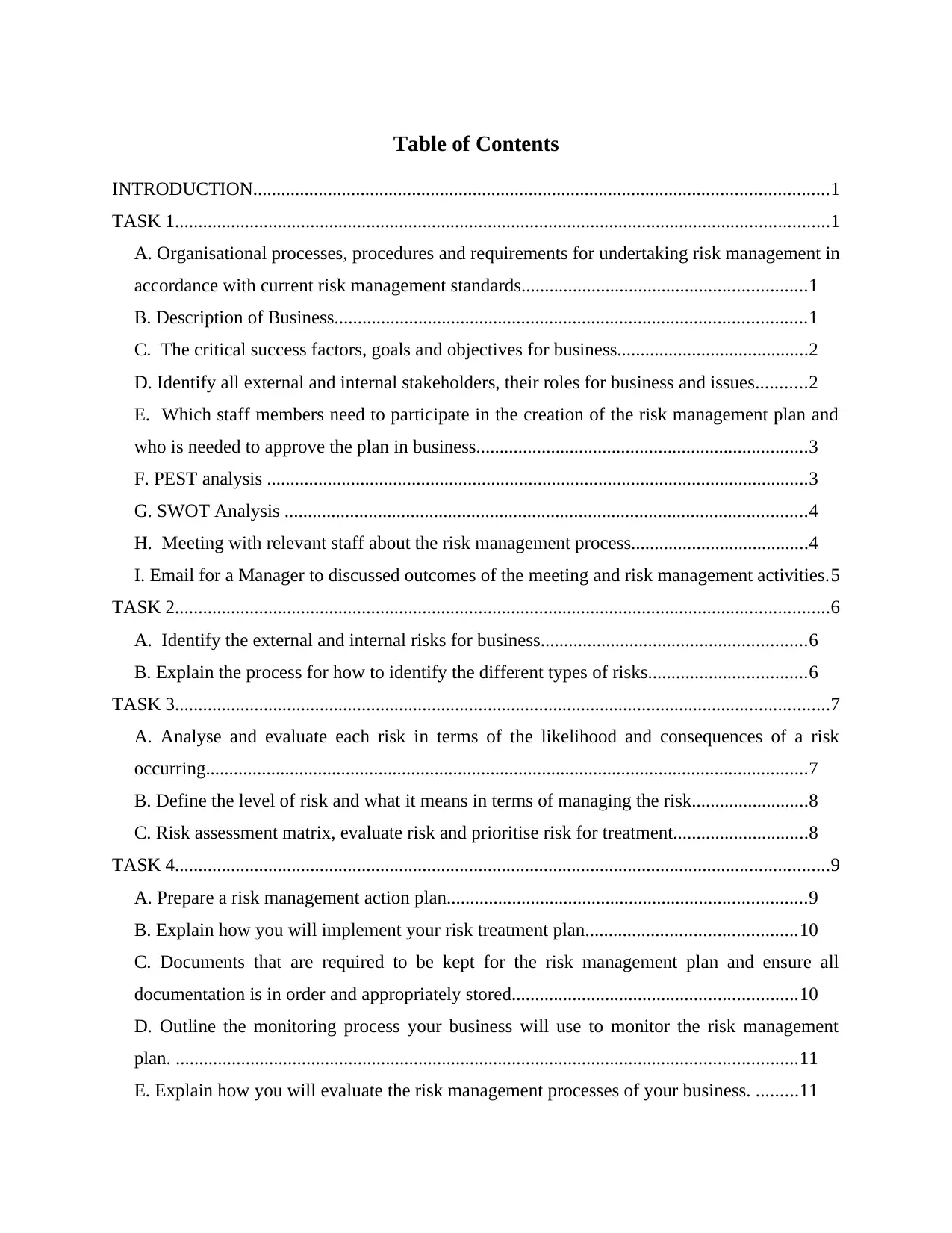
Table of Contents
INTRODUCTION...........................................................................................................................1
TASK 1............................................................................................................................................1
A. Organisational processes, procedures and requirements for undertaking risk management in
accordance with current risk management standards.............................................................1
B. Description of Business.....................................................................................................1
C. The critical success factors, goals and objectives for business.........................................2
D. Identify all external and internal stakeholders, their roles for business and issues...........2
E. Which staff members need to participate in the creation of the risk management plan and
who is needed to approve the plan in business.......................................................................3
F. PEST analysis ....................................................................................................................3
G. SWOT Analysis ................................................................................................................4
H. Meeting with relevant staff about the risk management process......................................4
I. Email for a Manager to discussed outcomes of the meeting and risk management activities.5
TASK 2............................................................................................................................................6
A. Identify the external and internal risks for business.........................................................6
B. Explain the process for how to identify the different types of risks..................................6
TASK 3............................................................................................................................................7
A. Analyse and evaluate each risk in terms of the likelihood and consequences of a risk
occurring.................................................................................................................................7
B. Define the level of risk and what it means in terms of managing the risk.........................8
C. Risk assessment matrix, evaluate risk and prioritise risk for treatment.............................8
TASK 4............................................................................................................................................9
A. Prepare a risk management action plan.............................................................................9
B. Explain how you will implement your risk treatment plan.............................................10
C. Documents that are required to be kept for the risk management plan and ensure all
documentation is in order and appropriately stored.............................................................10
D. Outline the monitoring process your business will use to monitor the risk management
plan. .....................................................................................................................................11
E. Explain how you will evaluate the risk management processes of your business. .........11
INTRODUCTION...........................................................................................................................1
TASK 1............................................................................................................................................1
A. Organisational processes, procedures and requirements for undertaking risk management in
accordance with current risk management standards.............................................................1
B. Description of Business.....................................................................................................1
C. The critical success factors, goals and objectives for business.........................................2
D. Identify all external and internal stakeholders, their roles for business and issues...........2
E. Which staff members need to participate in the creation of the risk management plan and
who is needed to approve the plan in business.......................................................................3
F. PEST analysis ....................................................................................................................3
G. SWOT Analysis ................................................................................................................4
H. Meeting with relevant staff about the risk management process......................................4
I. Email for a Manager to discussed outcomes of the meeting and risk management activities.5
TASK 2............................................................................................................................................6
A. Identify the external and internal risks for business.........................................................6
B. Explain the process for how to identify the different types of risks..................................6
TASK 3............................................................................................................................................7
A. Analyse and evaluate each risk in terms of the likelihood and consequences of a risk
occurring.................................................................................................................................7
B. Define the level of risk and what it means in terms of managing the risk.........................8
C. Risk assessment matrix, evaluate risk and prioritise risk for treatment.............................8
TASK 4............................................................................................................................................9
A. Prepare a risk management action plan.............................................................................9
B. Explain how you will implement your risk treatment plan.............................................10
C. Documents that are required to be kept for the risk management plan and ensure all
documentation is in order and appropriately stored.............................................................10
D. Outline the monitoring process your business will use to monitor the risk management
plan. .....................................................................................................................................11
E. Explain how you will evaluate the risk management processes of your business. .........11
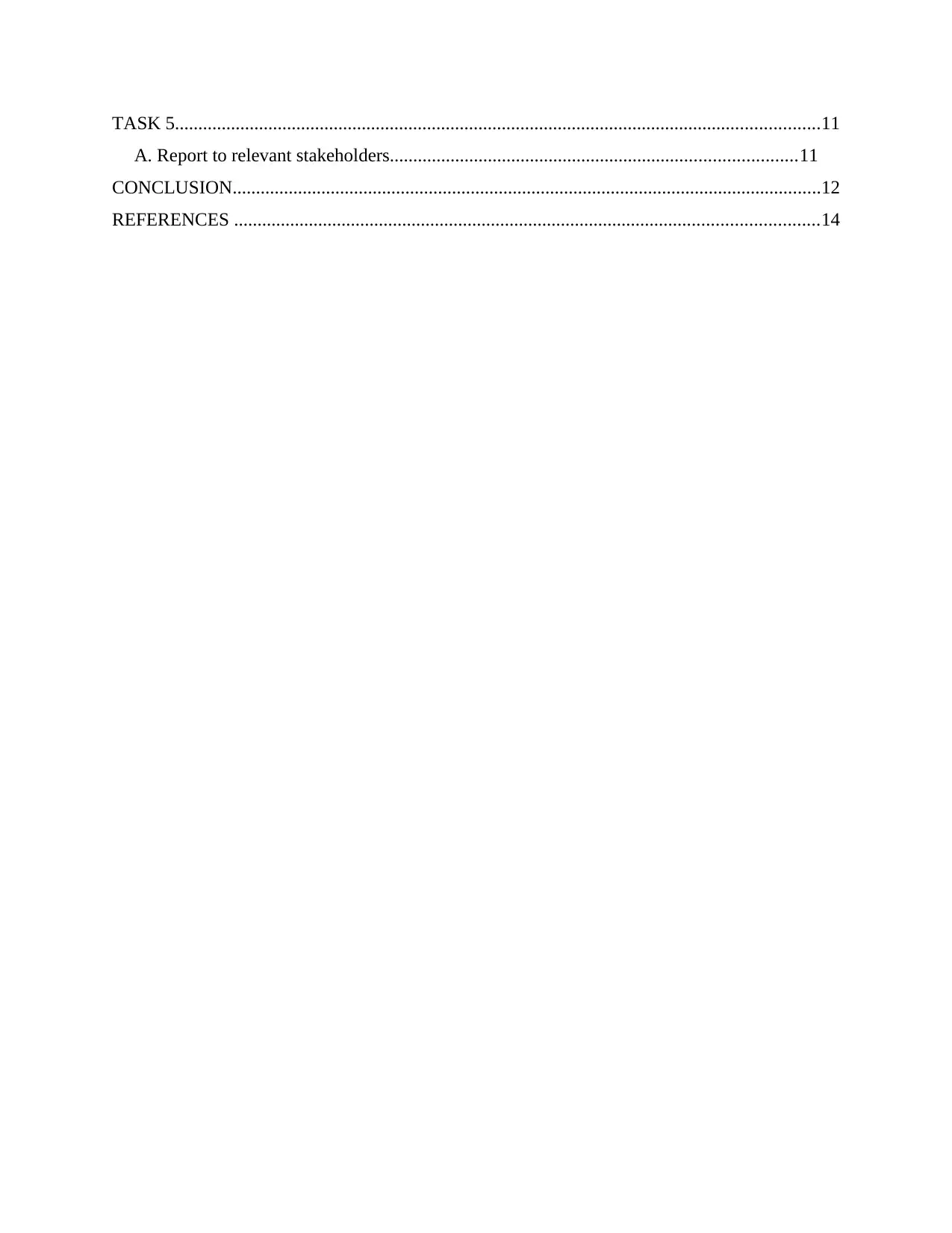
TASK 5..........................................................................................................................................11
A. Report to relevant stakeholders.......................................................................................11
CONCLUSION..............................................................................................................................12
REFERENCES .............................................................................................................................14
A. Report to relevant stakeholders.......................................................................................11
CONCLUSION..............................................................................................................................12
REFERENCES .............................................................................................................................14
⊘ This is a preview!⊘
Do you want full access?
Subscribe today to unlock all pages.

Trusted by 1+ million students worldwide
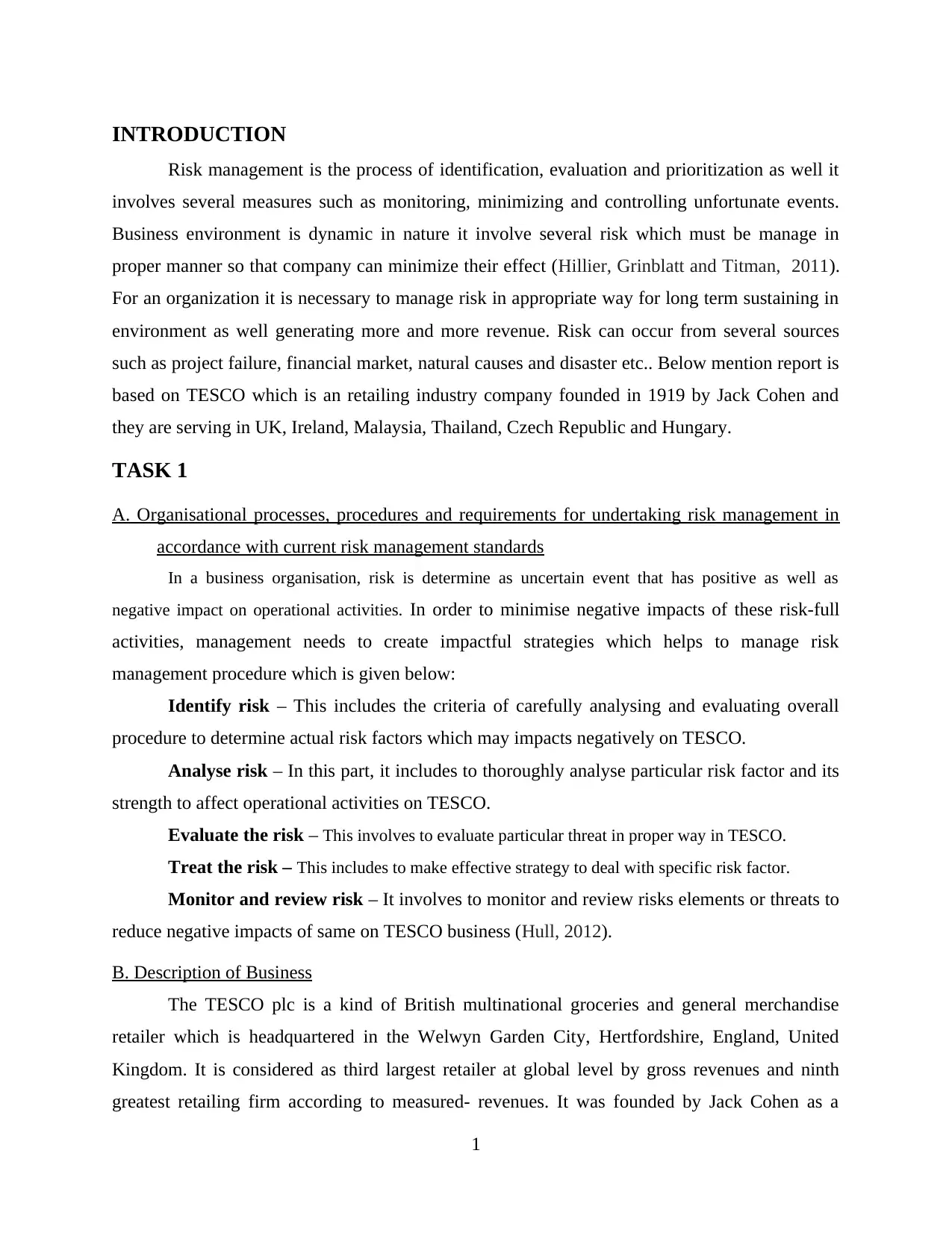
INTRODUCTION
Risk management is the process of identification, evaluation and prioritization as well it
involves several measures such as monitoring, minimizing and controlling unfortunate events.
Business environment is dynamic in nature it involve several risk which must be manage in
proper manner so that company can minimize their effect (Hillier, Grinblatt and Titman, 2011).
For an organization it is necessary to manage risk in appropriate way for long term sustaining in
environment as well generating more and more revenue. Risk can occur from several sources
such as project failure, financial market, natural causes and disaster etc.. Below mention report is
based on TESCO which is an retailing industry company founded in 1919 by Jack Cohen and
they are serving in UK, Ireland, Malaysia, Thailand, Czech Republic and Hungary.
TASK 1
A. Organisational processes, procedures and requirements for undertaking risk management in
accordance with current risk management standards
In a business organisation, risk is determine as uncertain event that has positive as well as
negative impact on operational activities. In order to minimise negative impacts of these risk-full
activities, management needs to create impactful strategies which helps to manage risk
management procedure which is given below:
Identify risk – This includes the criteria of carefully analysing and evaluating overall
procedure to determine actual risk factors which may impacts negatively on TESCO.
Analyse risk – In this part, it includes to thoroughly analyse particular risk factor and its
strength to affect operational activities on TESCO.
Evaluate the risk – This involves to evaluate particular threat in proper way in TESCO.
Treat the risk – This includes to make effective strategy to deal with specific risk factor.
Monitor and review risk – It involves to monitor and review risks elements or threats to
reduce negative impacts of same on TESCO business (Hull, 2012).
B. Description of Business
The TESCO plc is a kind of British multinational groceries and general merchandise
retailer which is headquartered in the Welwyn Garden City, Hertfordshire, England, United
Kingdom. It is considered as third largest retailer at global level by gross revenues and ninth
greatest retailing firm according to measured- revenues. It was founded by Jack Cohen as a
1
Risk management is the process of identification, evaluation and prioritization as well it
involves several measures such as monitoring, minimizing and controlling unfortunate events.
Business environment is dynamic in nature it involve several risk which must be manage in
proper manner so that company can minimize their effect (Hillier, Grinblatt and Titman, 2011).
For an organization it is necessary to manage risk in appropriate way for long term sustaining in
environment as well generating more and more revenue. Risk can occur from several sources
such as project failure, financial market, natural causes and disaster etc.. Below mention report is
based on TESCO which is an retailing industry company founded in 1919 by Jack Cohen and
they are serving in UK, Ireland, Malaysia, Thailand, Czech Republic and Hungary.
TASK 1
A. Organisational processes, procedures and requirements for undertaking risk management in
accordance with current risk management standards
In a business organisation, risk is determine as uncertain event that has positive as well as
negative impact on operational activities. In order to minimise negative impacts of these risk-full
activities, management needs to create impactful strategies which helps to manage risk
management procedure which is given below:
Identify risk – This includes the criteria of carefully analysing and evaluating overall
procedure to determine actual risk factors which may impacts negatively on TESCO.
Analyse risk – In this part, it includes to thoroughly analyse particular risk factor and its
strength to affect operational activities on TESCO.
Evaluate the risk – This involves to evaluate particular threat in proper way in TESCO.
Treat the risk – This includes to make effective strategy to deal with specific risk factor.
Monitor and review risk – It involves to monitor and review risks elements or threats to
reduce negative impacts of same on TESCO business (Hull, 2012).
B. Description of Business
The TESCO plc is a kind of British multinational groceries and general merchandise
retailer which is headquartered in the Welwyn Garden City, Hertfordshire, England, United
Kingdom. It is considered as third largest retailer at global level by gross revenues and ninth
greatest retailing firm according to measured- revenues. It was founded by Jack Cohen as a
1
Paraphrase This Document
Need a fresh take? Get an instant paraphrase of this document with our AI Paraphraser
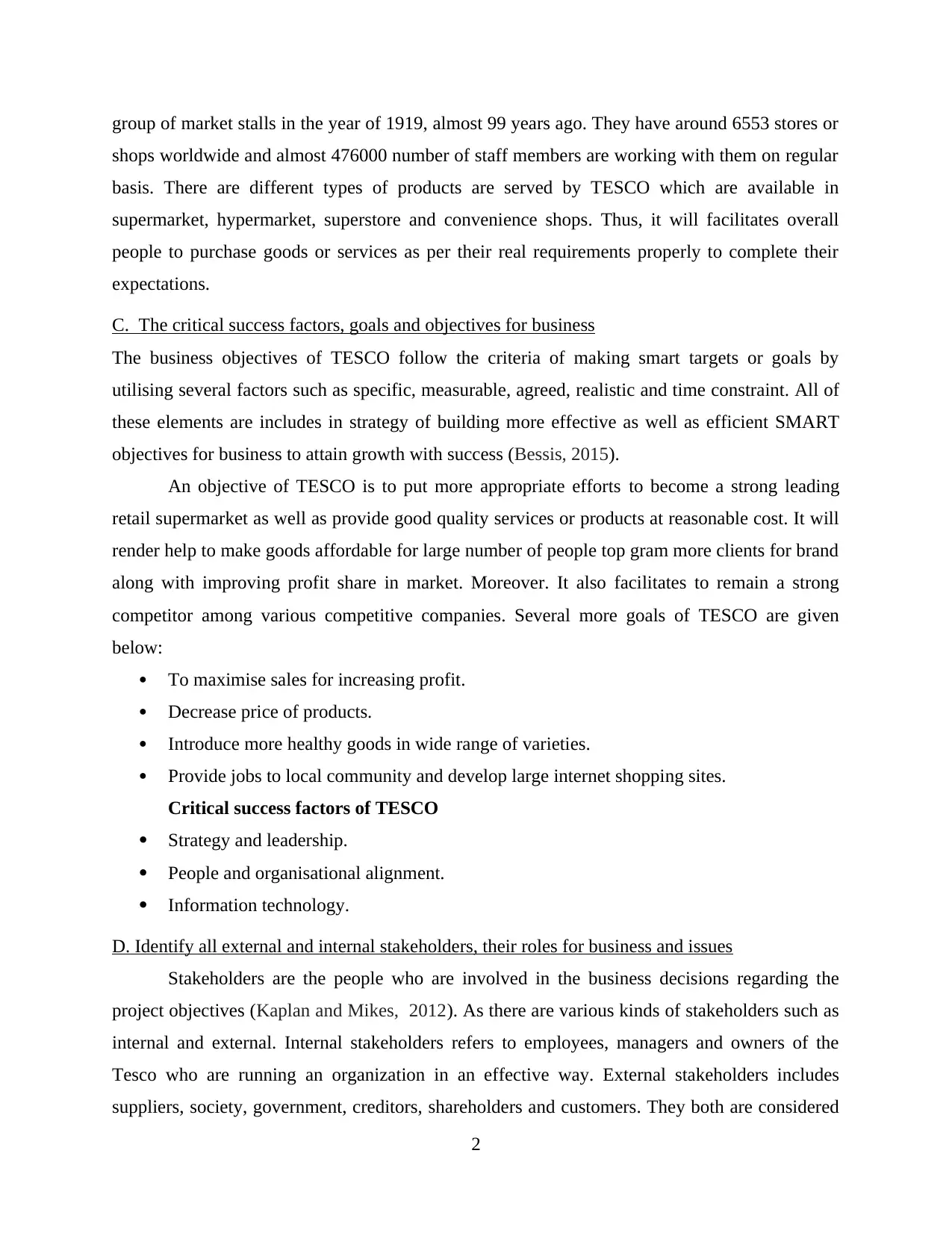
group of market stalls in the year of 1919, almost 99 years ago. They have around 6553 stores or
shops worldwide and almost 476000 number of staff members are working with them on regular
basis. There are different types of products are served by TESCO which are available in
supermarket, hypermarket, superstore and convenience shops. Thus, it will facilitates overall
people to purchase goods or services as per their real requirements properly to complete their
expectations.
C. The critical success factors, goals and objectives for business
The business objectives of TESCO follow the criteria of making smart targets or goals by
utilising several factors such as specific, measurable, agreed, realistic and time constraint. All of
these elements are includes in strategy of building more effective as well as efficient SMART
objectives for business to attain growth with success (Bessis, 2015).
An objective of TESCO is to put more appropriate efforts to become a strong leading
retail supermarket as well as provide good quality services or products at reasonable cost. It will
render help to make goods affordable for large number of people top gram more clients for brand
along with improving profit share in market. Moreover. It also facilitates to remain a strong
competitor among various competitive companies. Several more goals of TESCO are given
below:
To maximise sales for increasing profit.
Decrease price of products.
Introduce more healthy goods in wide range of varieties.
Provide jobs to local community and develop large internet shopping sites.
Critical success factors of TESCO
Strategy and leadership.
People and organisational alignment.
Information technology.
D. Identify all external and internal stakeholders, their roles for business and issues
Stakeholders are the people who are involved in the business decisions regarding the
project objectives (Kaplan and Mikes, 2012). As there are various kinds of stakeholders such as
internal and external. Internal stakeholders refers to employees, managers and owners of the
Tesco who are running an organization in an effective way. External stakeholders includes
suppliers, society, government, creditors, shareholders and customers. They both are considered
2
shops worldwide and almost 476000 number of staff members are working with them on regular
basis. There are different types of products are served by TESCO which are available in
supermarket, hypermarket, superstore and convenience shops. Thus, it will facilitates overall
people to purchase goods or services as per their real requirements properly to complete their
expectations.
C. The critical success factors, goals and objectives for business
The business objectives of TESCO follow the criteria of making smart targets or goals by
utilising several factors such as specific, measurable, agreed, realistic and time constraint. All of
these elements are includes in strategy of building more effective as well as efficient SMART
objectives for business to attain growth with success (Bessis, 2015).
An objective of TESCO is to put more appropriate efforts to become a strong leading
retail supermarket as well as provide good quality services or products at reasonable cost. It will
render help to make goods affordable for large number of people top gram more clients for brand
along with improving profit share in market. Moreover. It also facilitates to remain a strong
competitor among various competitive companies. Several more goals of TESCO are given
below:
To maximise sales for increasing profit.
Decrease price of products.
Introduce more healthy goods in wide range of varieties.
Provide jobs to local community and develop large internet shopping sites.
Critical success factors of TESCO
Strategy and leadership.
People and organisational alignment.
Information technology.
D. Identify all external and internal stakeholders, their roles for business and issues
Stakeholders are the people who are involved in the business decisions regarding the
project objectives (Kaplan and Mikes, 2012). As there are various kinds of stakeholders such as
internal and external. Internal stakeholders refers to employees, managers and owners of the
Tesco who are running an organization in an effective way. External stakeholders includes
suppliers, society, government, creditors, shareholders and customers. They both are considered
2
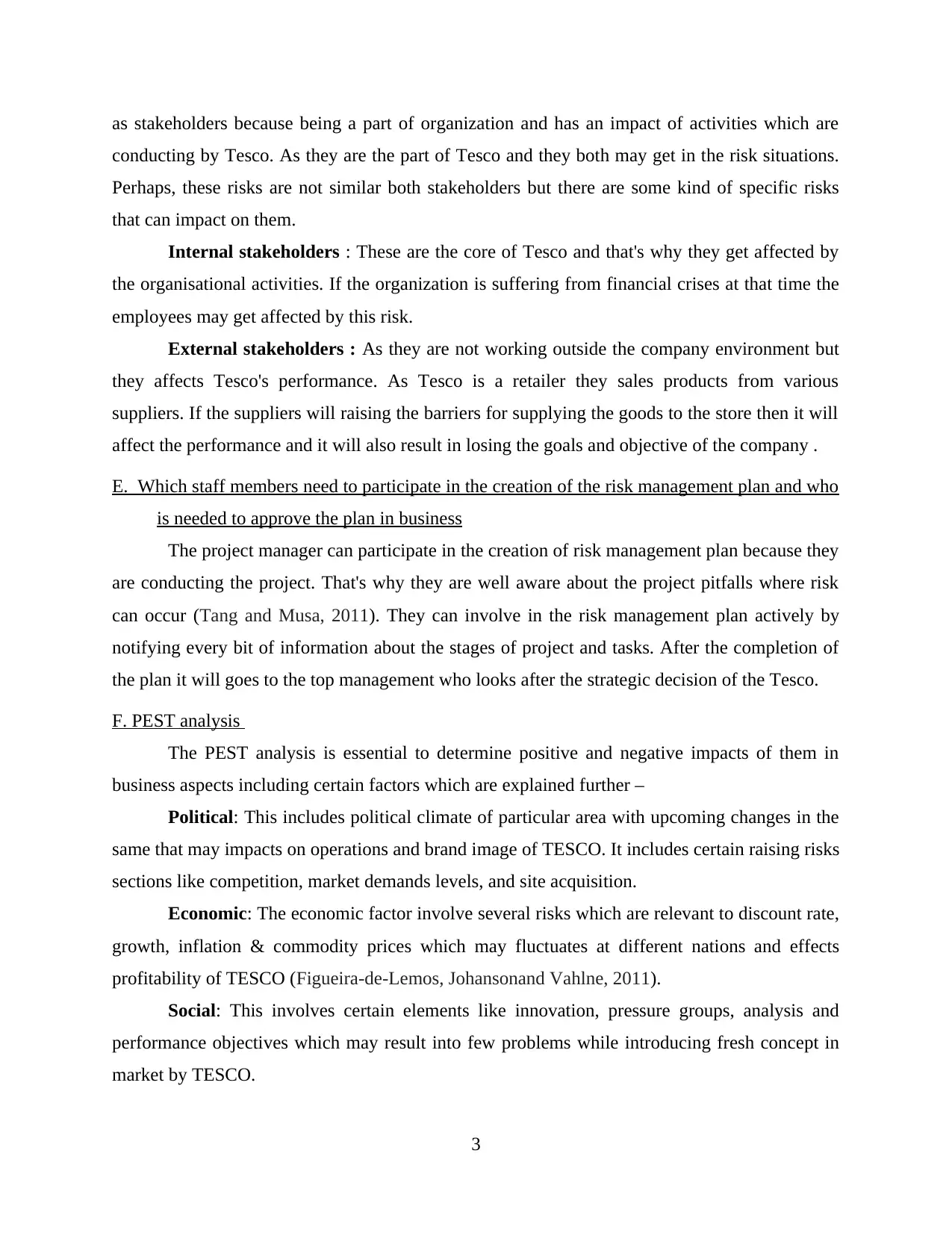
as stakeholders because being a part of organization and has an impact of activities which are
conducting by Tesco. As they are the part of Tesco and they both may get in the risk situations.
Perhaps, these risks are not similar both stakeholders but there are some kind of specific risks
that can impact on them.
Internal stakeholders : These are the core of Tesco and that's why they get affected by
the organisational activities. If the organization is suffering from financial crises at that time the
employees may get affected by this risk.
External stakeholders : As they are not working outside the company environment but
they affects Tesco's performance. As Tesco is a retailer they sales products from various
suppliers. If the suppliers will raising the barriers for supplying the goods to the store then it will
affect the performance and it will also result in losing the goals and objective of the company .
E. Which staff members need to participate in the creation of the risk management plan and who
is needed to approve the plan in business
The project manager can participate in the creation of risk management plan because they
are conducting the project. That's why they are well aware about the project pitfalls where risk
can occur (Tang and Musa, 2011). They can involve in the risk management plan actively by
notifying every bit of information about the stages of project and tasks. After the completion of
the plan it will goes to the top management who looks after the strategic decision of the Tesco.
F. PEST analysis
The PEST analysis is essential to determine positive and negative impacts of them in
business aspects including certain factors which are explained further –
Political: This includes political climate of particular area with upcoming changes in the
same that may impacts on operations and brand image of TESCO. It includes certain raising risks
sections like competition, market demands levels, and site acquisition.
Economic: The economic factor involve several risks which are relevant to discount rate,
growth, inflation & commodity prices which may fluctuates at different nations and effects
profitability of TESCO (Figueira-de-Lemos, Johansonand Vahlne, 2011).
Social: This involves certain elements like innovation, pressure groups, analysis and
performance objectives which may result into few problems while introducing fresh concept in
market by TESCO.
3
conducting by Tesco. As they are the part of Tesco and they both may get in the risk situations.
Perhaps, these risks are not similar both stakeholders but there are some kind of specific risks
that can impact on them.
Internal stakeholders : These are the core of Tesco and that's why they get affected by
the organisational activities. If the organization is suffering from financial crises at that time the
employees may get affected by this risk.
External stakeholders : As they are not working outside the company environment but
they affects Tesco's performance. As Tesco is a retailer they sales products from various
suppliers. If the suppliers will raising the barriers for supplying the goods to the store then it will
affect the performance and it will also result in losing the goals and objective of the company .
E. Which staff members need to participate in the creation of the risk management plan and who
is needed to approve the plan in business
The project manager can participate in the creation of risk management plan because they
are conducting the project. That's why they are well aware about the project pitfalls where risk
can occur (Tang and Musa, 2011). They can involve in the risk management plan actively by
notifying every bit of information about the stages of project and tasks. After the completion of
the plan it will goes to the top management who looks after the strategic decision of the Tesco.
F. PEST analysis
The PEST analysis is essential to determine positive and negative impacts of them in
business aspects including certain factors which are explained further –
Political: This includes political climate of particular area with upcoming changes in the
same that may impacts on operations and brand image of TESCO. It includes certain raising risks
sections like competition, market demands levels, and site acquisition.
Economic: The economic factor involve several risks which are relevant to discount rate,
growth, inflation & commodity prices which may fluctuates at different nations and effects
profitability of TESCO (Figueira-de-Lemos, Johansonand Vahlne, 2011).
Social: This involves certain elements like innovation, pressure groups, analysis and
performance objectives which may result into few problems while introducing fresh concept in
market by TESCO.
3
⊘ This is a preview!⊘
Do you want full access?
Subscribe today to unlock all pages.

Trusted by 1+ million students worldwide
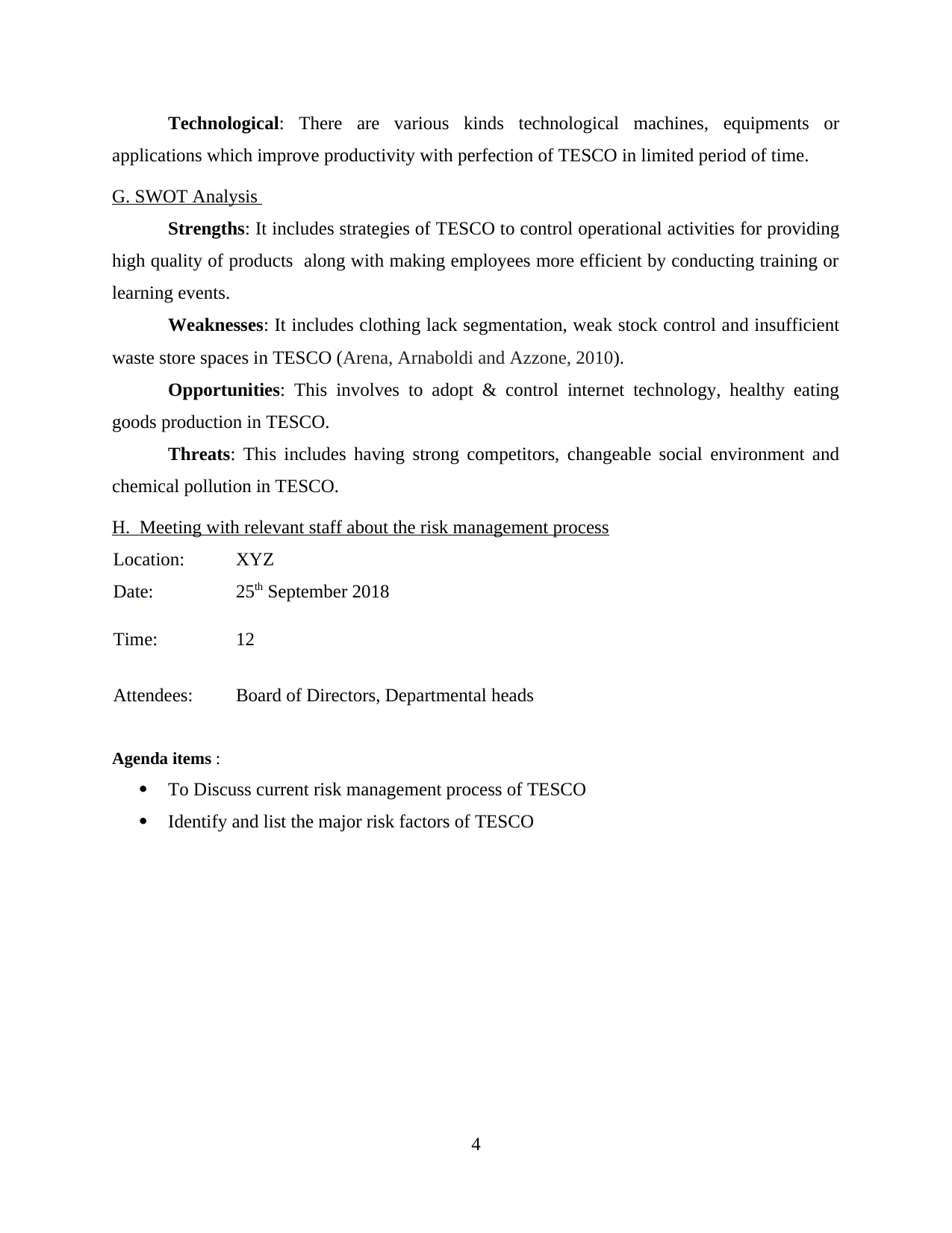
Technological: There are various kinds technological machines, equipments or
applications which improve productivity with perfection of TESCO in limited period of time.
G. SWOT Analysis
Strengths: It includes strategies of TESCO to control operational activities for providing
high quality of products along with making employees more efficient by conducting training or
learning events.
Weaknesses: It includes clothing lack segmentation, weak stock control and insufficient
waste store spaces in TESCO (Arena, Arnaboldi and Azzone, 2010).
Opportunities: This involves to adopt & control internet technology, healthy eating
goods production in TESCO.
Threats: This includes having strong competitors, changeable social environment and
chemical pollution in TESCO.
H. Meeting with relevant staff about the risk management process
Location: XYZ
Date: 25th September 2018
Time: 12
Attendees: Board of Directors, Departmental heads
Agenda items :
To Discuss current risk management process of TESCO
Identify and list the major risk factors of TESCO
4
applications which improve productivity with perfection of TESCO in limited period of time.
G. SWOT Analysis
Strengths: It includes strategies of TESCO to control operational activities for providing
high quality of products along with making employees more efficient by conducting training or
learning events.
Weaknesses: It includes clothing lack segmentation, weak stock control and insufficient
waste store spaces in TESCO (Arena, Arnaboldi and Azzone, 2010).
Opportunities: This involves to adopt & control internet technology, healthy eating
goods production in TESCO.
Threats: This includes having strong competitors, changeable social environment and
chemical pollution in TESCO.
H. Meeting with relevant staff about the risk management process
Location: XYZ
Date: 25th September 2018
Time: 12
Attendees: Board of Directors, Departmental heads
Agenda items :
To Discuss current risk management process of TESCO
Identify and list the major risk factors of TESCO
4
Paraphrase This Document
Need a fresh take? Get an instant paraphrase of this document with our AI Paraphraser
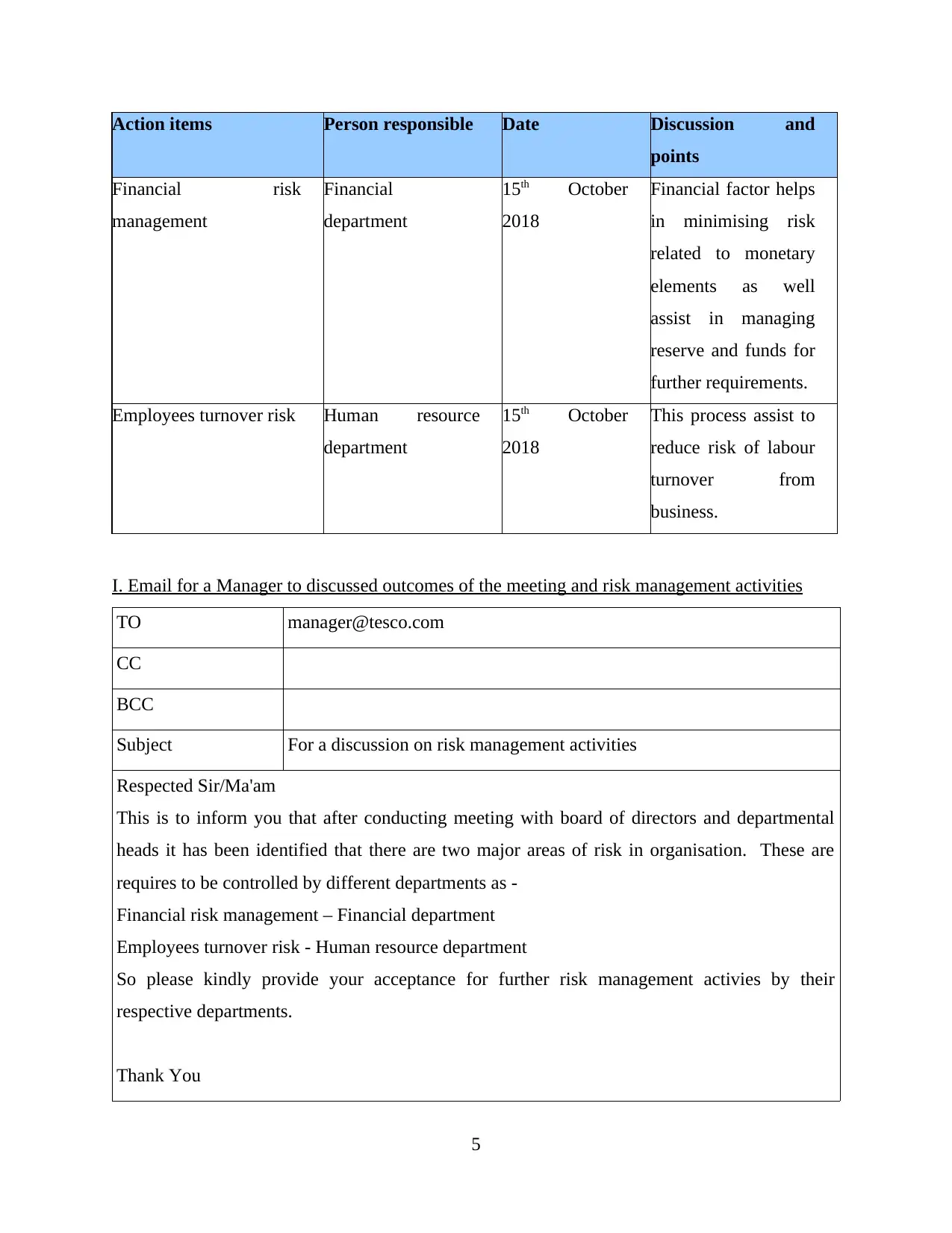
Action items Person responsible Date Discussion and
points
Financial risk
management
Financial
department
15th October
2018
Financial factor helps
in minimising risk
related to monetary
elements as well
assist in managing
reserve and funds for
further requirements.
Employees turnover risk Human resource
department
15th October
2018
This process assist to
reduce risk of labour
turnover from
business.
I. Email for a Manager to discussed outcomes of the meeting and risk management activities
TO manager@tesco.com
CC
BCC
Subject For a discussion on risk management activities
Respected Sir/Ma'am
This is to inform you that after conducting meeting with board of directors and departmental
heads it has been identified that there are two major areas of risk in organisation. These are
requires to be controlled by different departments as -
Financial risk management – Financial department
Employees turnover risk - Human resource department
So please kindly provide your acceptance for further risk management activies by their
respective departments.
Thank You
5
points
Financial risk
management
Financial
department
15th October
2018
Financial factor helps
in minimising risk
related to monetary
elements as well
assist in managing
reserve and funds for
further requirements.
Employees turnover risk Human resource
department
15th October
2018
This process assist to
reduce risk of labour
turnover from
business.
I. Email for a Manager to discussed outcomes of the meeting and risk management activities
TO manager@tesco.com
CC
BCC
Subject For a discussion on risk management activities
Respected Sir/Ma'am
This is to inform you that after conducting meeting with board of directors and departmental
heads it has been identified that there are two major areas of risk in organisation. These are
requires to be controlled by different departments as -
Financial risk management – Financial department
Employees turnover risk - Human resource department
So please kindly provide your acceptance for further risk management activies by their
respective departments.
Thank You
5
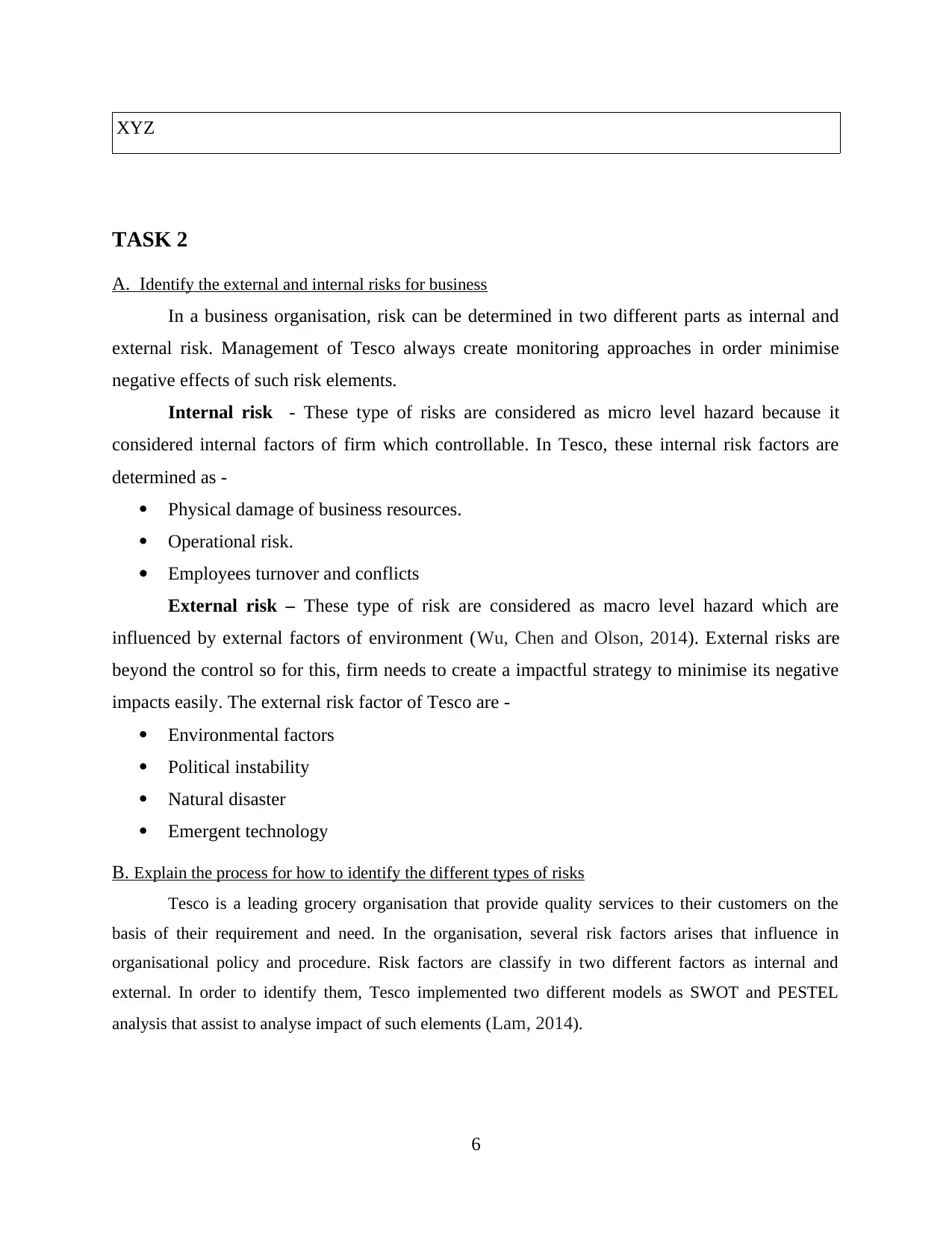
XYZ
TASK 2
A. Identify the external and internal risks for business
In a business organisation, risk can be determined in two different parts as internal and
external risk. Management of Tesco always create monitoring approaches in order minimise
negative effects of such risk elements.
Internal risk - These type of risks are considered as micro level hazard because it
considered internal factors of firm which controllable. In Tesco, these internal risk factors are
determined as -
Physical damage of business resources.
Operational risk.
Employees turnover and conflicts
External risk – These type of risk are considered as macro level hazard which are
influenced by external factors of environment (Wu, Chen and Olson, 2014). External risks are
beyond the control so for this, firm needs to create a impactful strategy to minimise its negative
impacts easily. The external risk factor of Tesco are -
Environmental factors
Political instability
Natural disaster
Emergent technology
B. Explain the process for how to identify the different types of risks
Tesco is a leading grocery organisation that provide quality services to their customers on the
basis of their requirement and need. In the organisation, several risk factors arises that influence in
organisational policy and procedure. Risk factors are classify in two different factors as internal and
external. In order to identify them, Tesco implemented two different models as SWOT and PESTEL
analysis that assist to analyse impact of such elements (Lam, 2014).
6
TASK 2
A. Identify the external and internal risks for business
In a business organisation, risk can be determined in two different parts as internal and
external risk. Management of Tesco always create monitoring approaches in order minimise
negative effects of such risk elements.
Internal risk - These type of risks are considered as micro level hazard because it
considered internal factors of firm which controllable. In Tesco, these internal risk factors are
determined as -
Physical damage of business resources.
Operational risk.
Employees turnover and conflicts
External risk – These type of risk are considered as macro level hazard which are
influenced by external factors of environment (Wu, Chen and Olson, 2014). External risks are
beyond the control so for this, firm needs to create a impactful strategy to minimise its negative
impacts easily. The external risk factor of Tesco are -
Environmental factors
Political instability
Natural disaster
Emergent technology
B. Explain the process for how to identify the different types of risks
Tesco is a leading grocery organisation that provide quality services to their customers on the
basis of their requirement and need. In the organisation, several risk factors arises that influence in
organisational policy and procedure. Risk factors are classify in two different factors as internal and
external. In order to identify them, Tesco implemented two different models as SWOT and PESTEL
analysis that assist to analyse impact of such elements (Lam, 2014).
6
⊘ This is a preview!⊘
Do you want full access?
Subscribe today to unlock all pages.

Trusted by 1+ million students worldwide
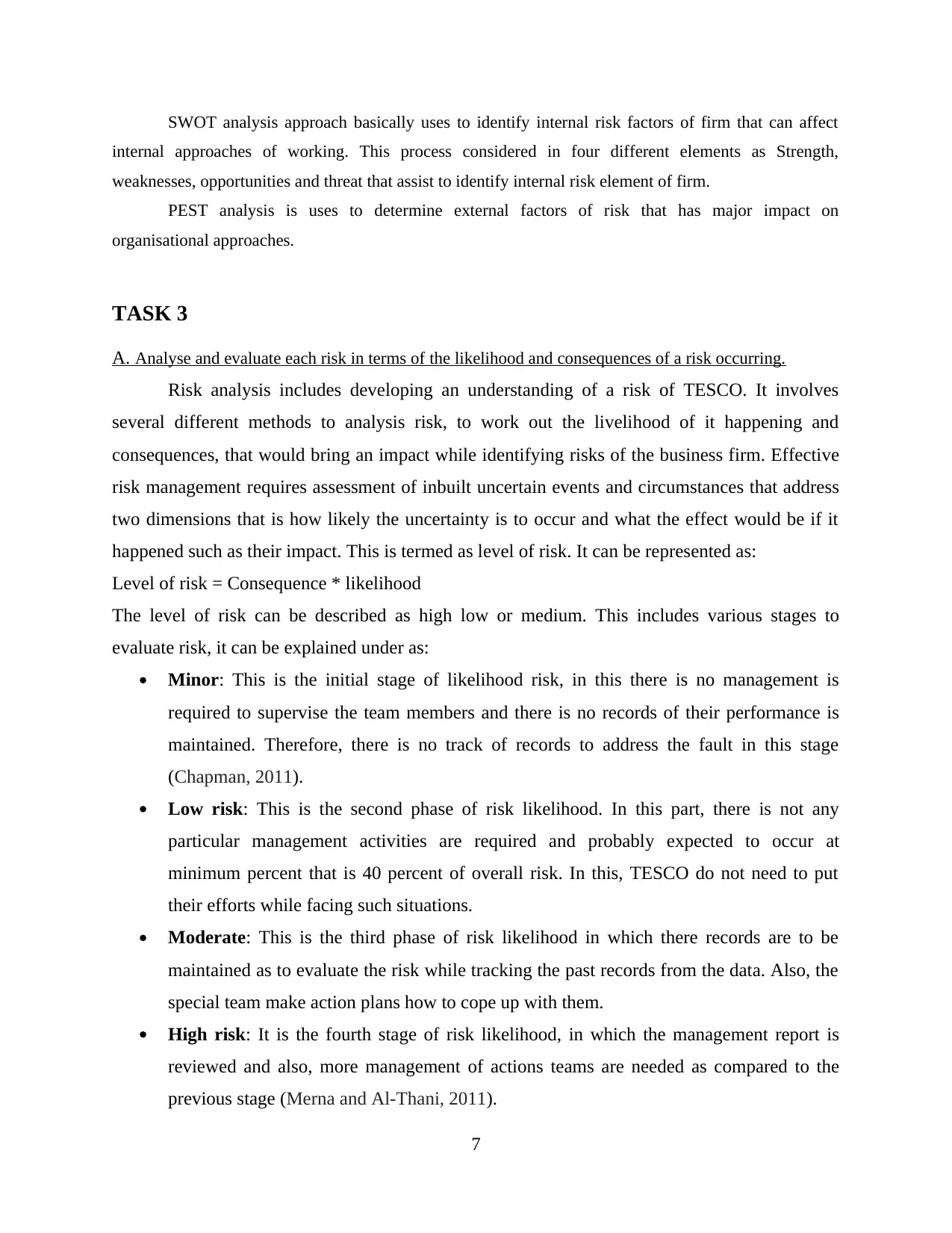
SWOT analysis approach basically uses to identify internal risk factors of firm that can affect
internal approaches of working. This process considered in four different elements as Strength,
weaknesses, opportunities and threat that assist to identify internal risk element of firm.
PEST analysis is uses to determine external factors of risk that has major impact on
organisational approaches.
TASK 3
A. Analyse and evaluate each risk in terms of the likelihood and consequences of a risk occurring.
Risk analysis includes developing an understanding of a risk of TESCO. It involves
several different methods to analysis risk, to work out the livelihood of it happening and
consequences, that would bring an impact while identifying risks of the business firm. Effective
risk management requires assessment of inbuilt uncertain events and circumstances that address
two dimensions that is how likely the uncertainty is to occur and what the effect would be if it
happened such as their impact. This is termed as level of risk. It can be represented as:
Level of risk = Consequence * likelihood
The level of risk can be described as high low or medium. This includes various stages to
evaluate risk, it can be explained under as:
Minor: This is the initial stage of likelihood risk, in this there is no management is
required to supervise the team members and there is no records of their performance is
maintained. Therefore, there is no track of records to address the fault in this stage
(Chapman, 2011).
Low risk: This is the second phase of risk likelihood. In this part, there is not any
particular management activities are required and probably expected to occur at
minimum percent that is 40 percent of overall risk. In this, TESCO do not need to put
their efforts while facing such situations.
Moderate: This is the third phase of risk likelihood in which there records are to be
maintained as to evaluate the risk while tracking the past records from the data. Also, the
special team make action plans how to cope up with them.
High risk: It is the fourth stage of risk likelihood, in which the management report is
reviewed and also, more management of actions teams are needed as compared to the
previous stage (Merna and Al-Thani, 2011).
7
internal approaches of working. This process considered in four different elements as Strength,
weaknesses, opportunities and threat that assist to identify internal risk element of firm.
PEST analysis is uses to determine external factors of risk that has major impact on
organisational approaches.
TASK 3
A. Analyse and evaluate each risk in terms of the likelihood and consequences of a risk occurring.
Risk analysis includes developing an understanding of a risk of TESCO. It involves
several different methods to analysis risk, to work out the livelihood of it happening and
consequences, that would bring an impact while identifying risks of the business firm. Effective
risk management requires assessment of inbuilt uncertain events and circumstances that address
two dimensions that is how likely the uncertainty is to occur and what the effect would be if it
happened such as their impact. This is termed as level of risk. It can be represented as:
Level of risk = Consequence * likelihood
The level of risk can be described as high low or medium. This includes various stages to
evaluate risk, it can be explained under as:
Minor: This is the initial stage of likelihood risk, in this there is no management is
required to supervise the team members and there is no records of their performance is
maintained. Therefore, there is no track of records to address the fault in this stage
(Chapman, 2011).
Low risk: This is the second phase of risk likelihood. In this part, there is not any
particular management activities are required and probably expected to occur at
minimum percent that is 40 percent of overall risk. In this, TESCO do not need to put
their efforts while facing such situations.
Moderate: This is the third phase of risk likelihood in which there records are to be
maintained as to evaluate the risk while tracking the past records from the data. Also, the
special team make action plans how to cope up with them.
High risk: It is the fourth stage of risk likelihood, in which the management report is
reviewed and also, more management of actions teams are needed as compared to the
previous stage (Merna and Al-Thani, 2011).
7
Paraphrase This Document
Need a fresh take? Get an instant paraphrase of this document with our AI Paraphraser
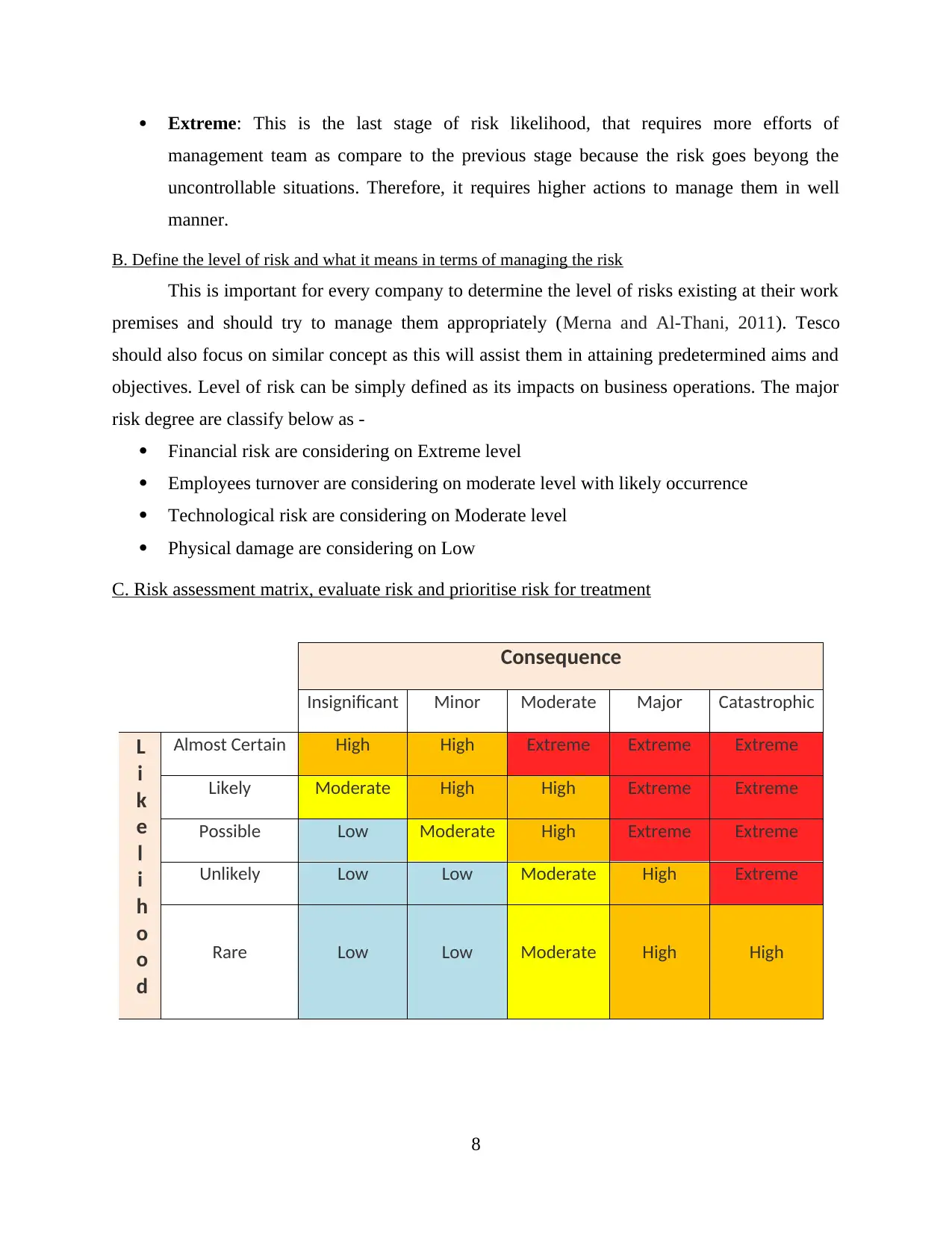
Extreme: This is the last stage of risk likelihood, that requires more efforts of
management team as compare to the previous stage because the risk goes beyong the
uncontrollable situations. Therefore, it requires higher actions to manage them in well
manner.
B. Define the level of risk and what it means in terms of managing the risk
This is important for every company to determine the level of risks existing at their work
premises and should try to manage them appropriately (Merna and Al-Thani, 2011). Tesco
should also focus on similar concept as this will assist them in attaining predetermined aims and
objectives. Level of risk can be simply defined as its impacts on business operations. The major
risk degree are classify below as -
Financial risk are considering on Extreme level
Employees turnover are considering on moderate level with likely occurrence
Technological risk are considering on Moderate level
Physical damage are considering on Low
C. Risk assessment matrix, evaluate risk and prioritise risk for treatment
Consequence
Insignificant Minor Moderate Major Catastrophic
L
i
k
e
l
i
h
o
o
d
Almost Certain High High Extreme Extreme Extreme
Likely Moderate High High Extreme Extreme
Possible Low Moderate High Extreme Extreme
Unlikely Low Low Moderate High Extreme
Rare Low Low Moderate High High
8
management team as compare to the previous stage because the risk goes beyong the
uncontrollable situations. Therefore, it requires higher actions to manage them in well
manner.
B. Define the level of risk and what it means in terms of managing the risk
This is important for every company to determine the level of risks existing at their work
premises and should try to manage them appropriately (Merna and Al-Thani, 2011). Tesco
should also focus on similar concept as this will assist them in attaining predetermined aims and
objectives. Level of risk can be simply defined as its impacts on business operations. The major
risk degree are classify below as -
Financial risk are considering on Extreme level
Employees turnover are considering on moderate level with likely occurrence
Technological risk are considering on Moderate level
Physical damage are considering on Low
C. Risk assessment matrix, evaluate risk and prioritise risk for treatment
Consequence
Insignificant Minor Moderate Major Catastrophic
L
i
k
e
l
i
h
o
o
d
Almost Certain High High Extreme Extreme Extreme
Likely Moderate High High Extreme Extreme
Possible Low Moderate High Extreme Extreme
Unlikely Low Low Moderate High Extreme
Rare Low Low Moderate High High
8
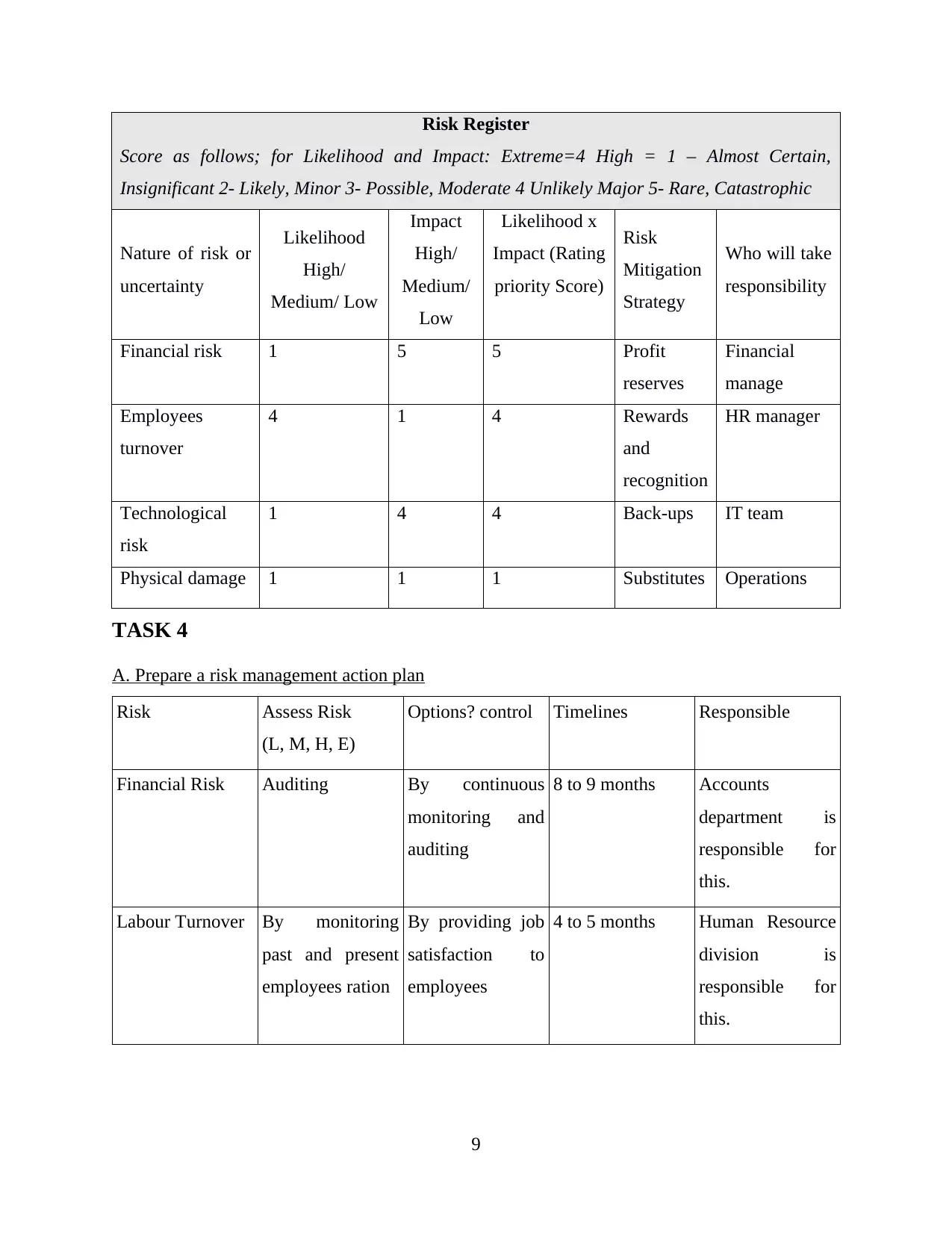
Risk Register
Score as follows; for Likelihood and Impact: Extreme=4 High = 1 – Almost Certain,
Insignificant 2- Likely, Minor 3- Possible, Moderate 4 Unlikely Major 5- Rare, Catastrophic
Nature of risk or
uncertainty
Likelihood
High/
Medium/ Low
Impact
High/
Medium/
Low
Likelihood x
Impact (Rating
priority Score)
Risk
Mitigation
Strategy
Who will take
responsibility
Financial risk 1 5 5 Profit
reserves
Financial
manage
Employees
turnover
4 1 4 Rewards
and
recognition
HR manager
Technological
risk
1 4 4 Back-ups IT team
Physical damage 1 1 1 Substitutes Operations
TASK 4
A. Prepare a risk management action plan
Risk Assess Risk
(L, M, H, E)
Options? control Timelines Responsible
Financial Risk Auditing By continuous
monitoring and
auditing
8 to 9 months Accounts
department is
responsible for
this.
Labour Turnover By monitoring
past and present
employees ration
By providing job
satisfaction to
employees
4 to 5 months Human Resource
division is
responsible for
this.
9
Score as follows; for Likelihood and Impact: Extreme=4 High = 1 – Almost Certain,
Insignificant 2- Likely, Minor 3- Possible, Moderate 4 Unlikely Major 5- Rare, Catastrophic
Nature of risk or
uncertainty
Likelihood
High/
Medium/ Low
Impact
High/
Medium/
Low
Likelihood x
Impact (Rating
priority Score)
Risk
Mitigation
Strategy
Who will take
responsibility
Financial risk 1 5 5 Profit
reserves
Financial
manage
Employees
turnover
4 1 4 Rewards
and
recognition
HR manager
Technological
risk
1 4 4 Back-ups IT team
Physical damage 1 1 1 Substitutes Operations
TASK 4
A. Prepare a risk management action plan
Risk Assess Risk
(L, M, H, E)
Options? control Timelines Responsible
Financial Risk Auditing By continuous
monitoring and
auditing
8 to 9 months Accounts
department is
responsible for
this.
Labour Turnover By monitoring
past and present
employees ration
By providing job
satisfaction to
employees
4 to 5 months Human Resource
division is
responsible for
this.
9
⊘ This is a preview!⊘
Do you want full access?
Subscribe today to unlock all pages.

Trusted by 1+ million students worldwide
1 out of 17
Related Documents
Your All-in-One AI-Powered Toolkit for Academic Success.
+13062052269
info@desklib.com
Available 24*7 on WhatsApp / Email
![[object Object]](/_next/static/media/star-bottom.7253800d.svg)
Unlock your academic potential
Copyright © 2020–2025 A2Z Services. All Rights Reserved. Developed and managed by ZUCOL.





